Three-Dimensional Simulation of the Operating Characteristics of Cell Layers in Solid Oxide Fuel Cells
Abstract
:1. Introduction
2. Methodology
2.1. Mathematical Equations
2.2. Model Establishment
2.3. Mesh Generation
3. Results and Discussion
3.1. Comparison of Changes in the Porosity of the Electrolyte Layer and Molar Concentration
3.2. Distribution of Voltage and Current on the Electrolyte Layer Surface
3.3. Comparison of Influence of Temperature on the SOFC Performance
3.4. Comparison of Simulation and Experimental Results at Different Temperatures
4. Conclusions
Funding
Institutional Review Board Statement
Informed Consent Statement
Data Availability Statement
Acknowledgments
Conflicts of Interest
Abbreviations
| SOFC | Solid oxide fuel cell |
| 2D | Two-dimensional |
| 3D | Three-dimensional |
References
- Blum, L.; De Haart, L.B.; Malzbender, J.; Menzler, N.H.; Remmel, J.; Steinberger-Wilckens, R. Recent results in Jülich solid oxide fuel cell technology development. J. Power Sources 2013, 241, 477–485. [Google Scholar] [CrossRef]
- Lee, S.; Kim, H.; Yoon, K.J.; Son, J.-W.; Lee, J.-H.; Kim, B.-K.; Choi, W.; Hong, J. The effect of fuel utilization on heat and mass transfer within solid oxide fuel cells examined by three−dimensional numerical simulations. Int. J. Heat Mass Transfer 2016, 97, 77–93. [Google Scholar] [CrossRef]
- Ghorbani, B.; Vijayaraghavan, K. A review study on software-based modeling of hydrogen-fueled solid oxide fuel cells. Int. J. Hydrogen Energy 2019, 44, 13700–13727. [Google Scholar] [CrossRef]
- Yu, J.-W.; Jung, G.-B.; Chen, C.-W.; Yeh, C.-C.; Nguyen, X.-V.; Ma, C.-C.; Hsieh, C.-W.; Lin, C.-L. Innovative anode catalyst designed to reduce the degradation in ozone generation via PEM water electrolysis. Renew. Energy 2018, 129, 800–805. [Google Scholar] [CrossRef]
- Luo, Y.; Shi, Y.; Zheng, Y.; Cai, N. Reversible solid oxide fuel cell for natural gas/renewable hybrid power generation systems. J. Power Sources 2017, 340, 60–70. [Google Scholar] [CrossRef]
- Andersson, M.; Yuan, J.; Sundén, B. Review on modeling development for mul-tiscale chemical reactions coupled transport phenomena in solid oxide fuel cells. Appl. Energy 2010, 87, 1461–1476. [Google Scholar] [CrossRef]
- Nerat, M.; Juricic, D. A comprehensive 3-D modeling of a single planar solid oxide fuel cell. Int. J. Hydrogen Energy 2016, 41, 3613–3627. [Google Scholar] [CrossRef]
- Autissier, N.; Larrain, D.; Van Herle, J.; Favrat, D. CFD simulation tool for solid oxide fuel cells. J. Power Sources 2004, 131, 313–319. [Google Scholar] [CrossRef]
- Grew, K.N.; Chiu, W.K.S. A review of modeling and simulation techniques across the length scales for the solid oxide fuel cell. J. Power Sources 2012, 199, 1–13. [Google Scholar] [CrossRef]
- Razbani, O.; Assadi, M.; Andersson, M. Three dimensional CFD modeling and experimental validation of an electrolyte supported solid oxide fuel cell fed with methane-free biogas. Int. J. Hydrogen Energy 2013, 38, 10068–10080. [Google Scholar] [CrossRef]
- Liu, H.; Li, P.; Van Lew, J. CFD study on flow distribution uniformity in fuel distributors having multiple structural bifurcations of flow channels. Int. J. Hydrogen Energy 2010, 35, 9186–9198. [Google Scholar] [CrossRef]
- Liu, S.; Kong, W.; Lin, Z. Three-dimensional modeling of planar solid oxide fuel cells and the rib design optimization. J. Power Sources 2009, 194, 854–863. [Google Scholar] [CrossRef]
- Kim, Y.J.; Lee, M.C. Numerical investigation of flow/heat transfer and structural stress in a planar solid oxide fuel cell. Int. J. Hydrogen Energy 2017, 42, 18504–18513. [Google Scholar] [CrossRef]
- Lin, B.; Shi, Y.; Ni, M.; Cai, N. Numerical investigation on impacts on fuel velocity distribution nonuniformity among solid oxide fuel cell unit channels. Int. J. Hydrogen Energy 2015, 40, 3035–3047. [Google Scholar] [CrossRef]
- Bhattacharya, D.; Mukhopadhyay, J.; Biswas, N.; Basu, R.N.; Das, P.K. Performance evaluation of different bipolar plate designs of 3D planar anode-supported SOFCs. Int. J. Heat Mass Transfer 2018, 123, 382–396. [Google Scholar] [CrossRef]
- Duhn, J.D.; Jensen, A.D.; Wedel, S.; Wix, C. Optimization of a new flow design for solid oxide cells using computational fluid dynamics modelling. J. Power Sources 2016, 336, 261–271. [Google Scholar] [CrossRef]
- Saied, M.; Ahmed, K.; Nemat-Alla, M.; Ahmed, M.; El-Sebaie, M. Performance study of solid oxide fuel cell with various flow field designs: Numerical study. Int. J. Hydrogen Energy 2018, 46, 20931–20946. [Google Scholar] [CrossRef]
- Kapadia, S.; Anderson, W.K.; Burdyshaw, C. Channel shape optimization of solid oxide fuel cells using advanced numerical techniques. Comput. Fluids 2014, 41, 41–50. [Google Scholar] [CrossRef]
- Danilov, V.A.; Tade, M.O. A CFD-based model of a planar SOFC for anode flow field design. Int. J. Hydrogen Energy 2009, 34, 8998–9006. [Google Scholar] [CrossRef]
- Zhan, R.; Wang, Y.; Ni, M.; Zhang, G.; Du, Q.; Jiao, K. Three-dimensional simulation of solid oxide fuel cell with metal foam as cathode flow distributor. Int. J. Hydrogen Energy 2020, 45, 6897–6911. [Google Scholar] [CrossRef]
- Li, X.; Shi, W.; Han, M. Optimization of interconnect flow channels width in a planar solid oxide fuel cell. Int. J. Hydrogen Energy 2018, 43, 21524–21534. [Google Scholar] [CrossRef]
- Tushar Choudhary, S. Computational analysis of IR-SOFC: Thermodynamic, electrochemical process and flow configuration dependency. Int. J. Hydrogen Energy 2016, 41, 1259–1271. [Google Scholar] [CrossRef]
- Peksen, M. 3D CFD/FEM analysis of thermomechanical long-term behavior in SOFCs: Furnace operation with different fuel gases. Int. J. Hydrogen Energy 2015, 40, 12362–12369. [Google Scholar] [CrossRef]
- Konno, A.; Iwai, H.; Inuyama, K.; Kuroyanagi, A.; Saito, M.; Yoshida, H.; Kodani, K.; Yoshikata, K. Mesoscale-structure control at anode/electrolyte interface in solid oxide fuel cell. J. Power Sources 2011, 196, 98–109. [Google Scholar] [CrossRef]
- Dong, S.K.; Jung, W.N.; Rashid, K.; Kashimoto, A. Design and numerical analysis of a planar anode-supported SOFC stack. Renew. Energy 2016, 94, 637–650. [Google Scholar] [CrossRef]
- Ho, T.X.; Kosinski, P.; Hoffmann, A.C.; Vik, A. Numerical analysis of a planar anode-supported SOFC with composite electrodes. Int. J. Hydrogen Energy 2009, 34, 3488–3499. [Google Scholar] [CrossRef]
- Ho, T.X.; Kosinski, P.; Hoffmann, A.C.; Vik, A. Transport, chemical and electrochemical processes in a planar solid oxide fuel cell: Detailed three−dimensional modeling. J. Power Sources 2010, 195, 6764–6773. [Google Scholar] [CrossRef]
- Ho, T.X. A three-dimensional model for transient performance of a solid oxide fuel cell. Int. J. Hydrogen Energy 2014, 39, 6680–6688. [Google Scholar] [CrossRef]
- Kim, Y.J.; Lee, M.C. The influence of flow direction variation on the performance of a single cell for an anode-substrate flat-panel solid oxide fuel cell. Int. J. Hydrogen Energy 2020, 45, 20369–20381. [Google Scholar] [CrossRef]
- Park, J.; Li, P.; Bae, J. Analysis of chemical, electrochemical reactions and thermo-fluid flow in methane-feed internal reforming SOFCs: Part I—Modeling and effect of gas concentrations. Int. J. Hydrogen Energy 2012, 37, 8512–8531. [Google Scholar] [CrossRef]
- Park, J.; Li, P.; Bae, J. Analysis of chemical, electrochemical reactions and thermo-fluid flow in methane-feed internal reforming SOFCs: Part II—Temperature effect. Int. J. Hydrogen Energy 2012, 37, 8532–8555. [Google Scholar] [CrossRef]
- Celik, A.N. Three-dimensional multiphysics model of a planar solid oxide fuel cell using computational fluid dynamics approach. Int. J. Hydrogen Energy 2018, 43, 19730–19748. [Google Scholar] [CrossRef]
- Xu, M.; Li, T.S.; Yang, M.; Andersson, M.; Fransson, I.; Larsson, T.; Sundén, B. Modeling of an anode supported solid oxide fuel cell focusing on thermal stresses. Int. J. Hydrogen Energy 2016, 41, 14927–14940. [Google Scholar] [CrossRef]
- Wang, Y.; Zhan, R.; Qin, Y.; Zhang, G.; Du, Q.; Jiao, K. Three-dimensional modeling of pressure effect on operating characteristics and performance of solid oxide fuel cell. Int. J. Hydrogen Energy 2018, 43, 20059–20076. [Google Scholar] [CrossRef]
- Jiang, C.; Gu, Y.; Guan, W.; Zheng, J.; Ni, M.; Zhong, Z. 3D thermo-electro-chemo-mechanical coupled modeling of solid oxide fuel cell with double-sided cathodes. Int. J. Hydrogen Energy 2020, 45, 904–915. [Google Scholar] [CrossRef]
- Su, A.; Ferng, Y.-M.; Wang, C.B. Investigating parametric effects on performance of a high-temperature URSOFC. Int. J. Energy Res. 2015, 39, 648–660. [Google Scholar] [CrossRef]
- Su, A.; Ferng, Y.M.; Wang, C.B.; Cheng, C.H. Analytically investigating the characteristics of a high temperature unitized regenerative solid oxide fuel cell. Int. J. Energy Res. 2013, 37, 1699–1708. [Google Scholar] [CrossRef]
- Xu, H.; Chen, B.; Tan, P.; Cai, W.; He, W.; Farrusseng, D.; Ni, M. Modeling of all porous solid oxide fuel cells. Appl. Energy 2018, 219, 105–113. [Google Scholar] [CrossRef]
- Xu, H.; Chen, B.; Liu, J.; Ni, M. Modeling of direct carbon solid oxide fuel cell for CO and electricity cogeneration. Appl. Energy 2016, 178, 353–362. [Google Scholar] [CrossRef]
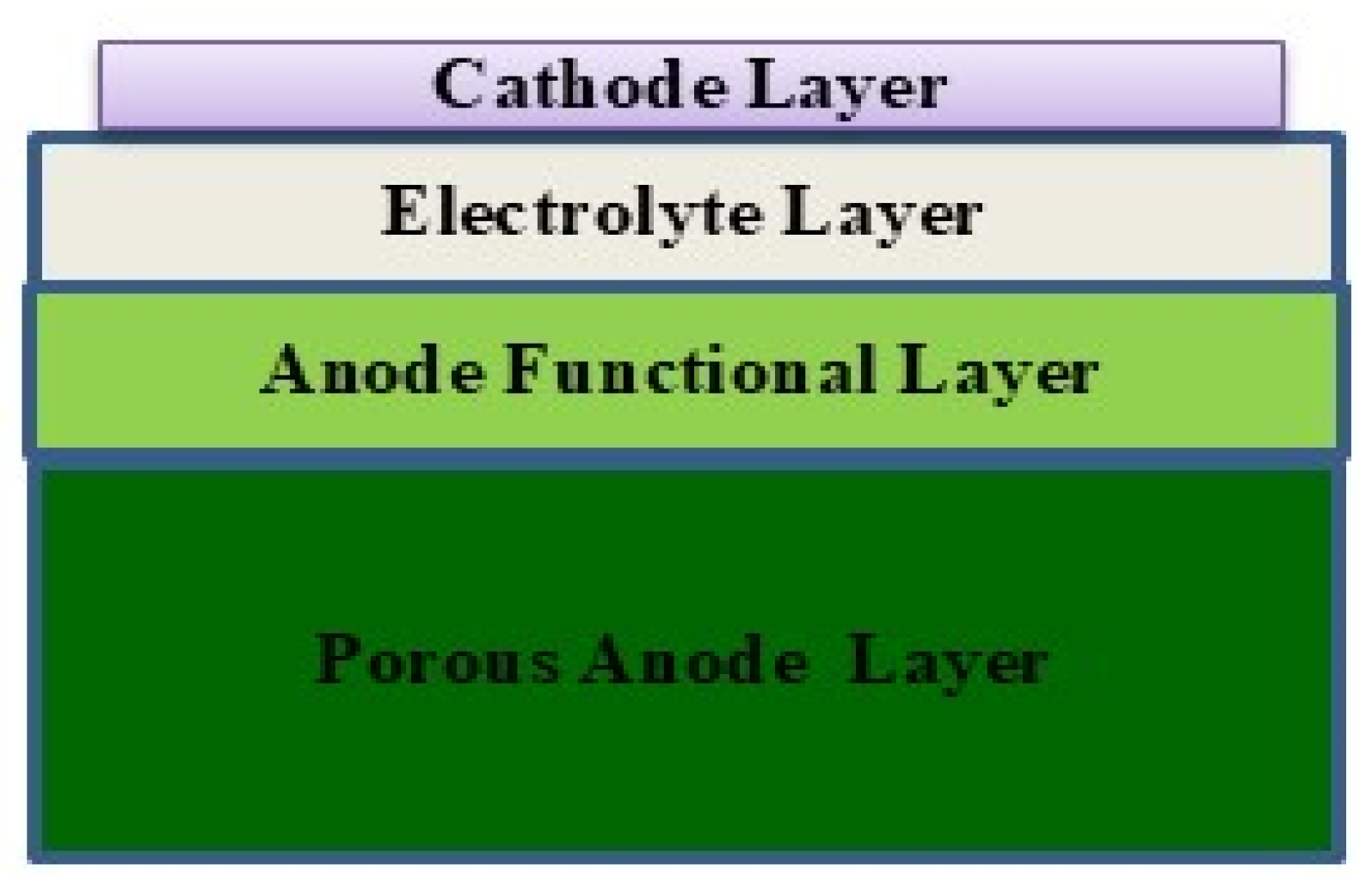
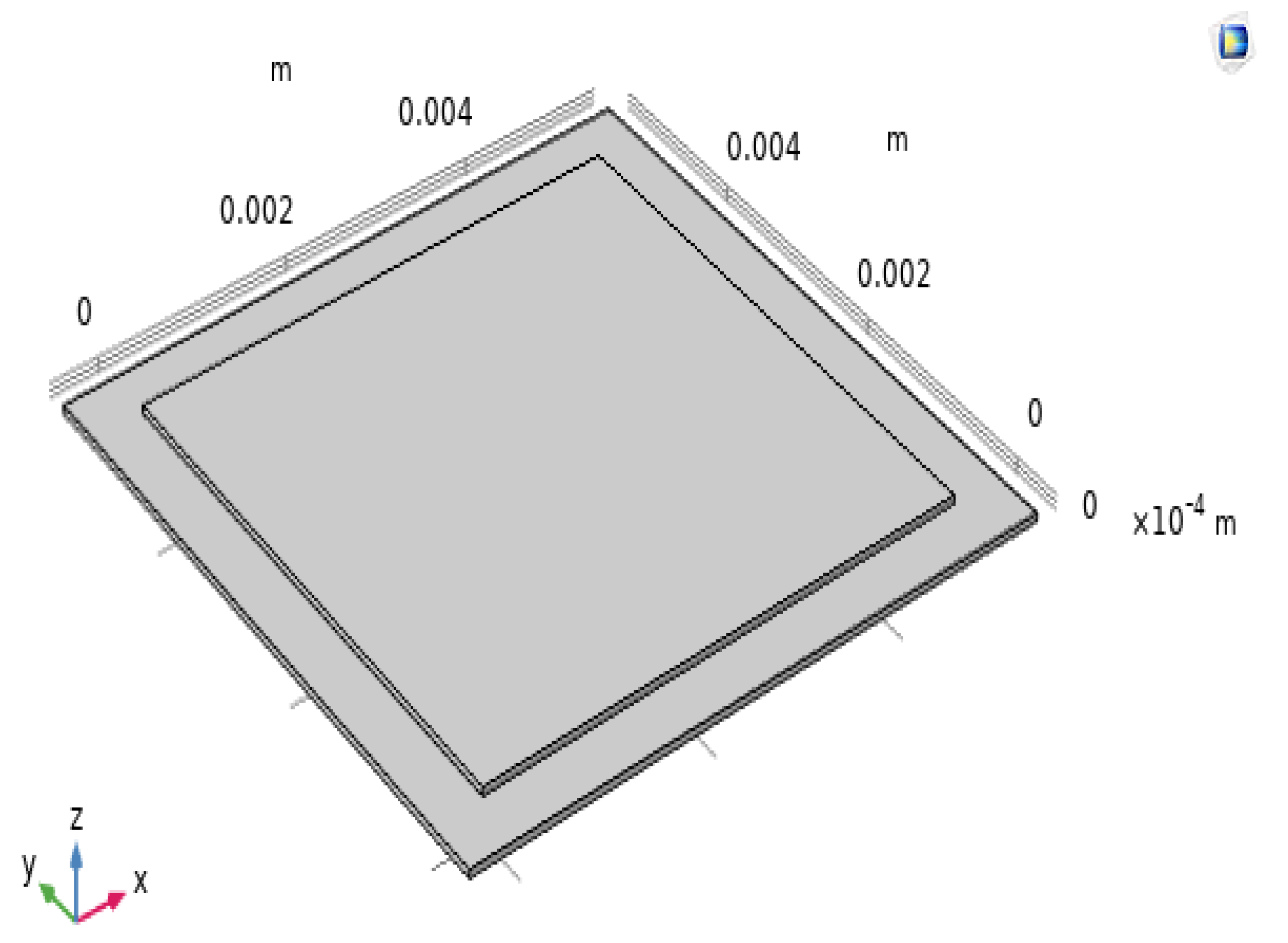
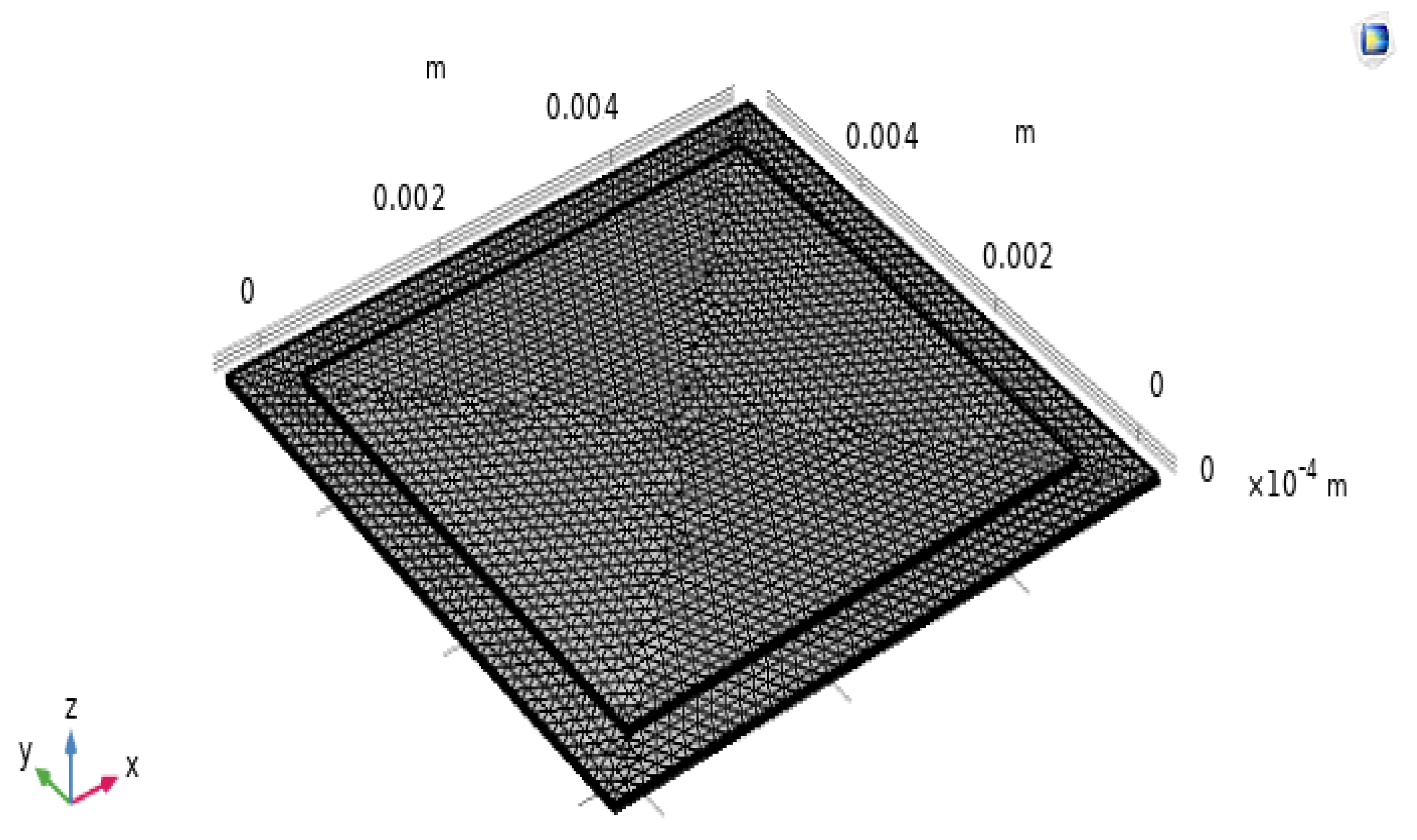
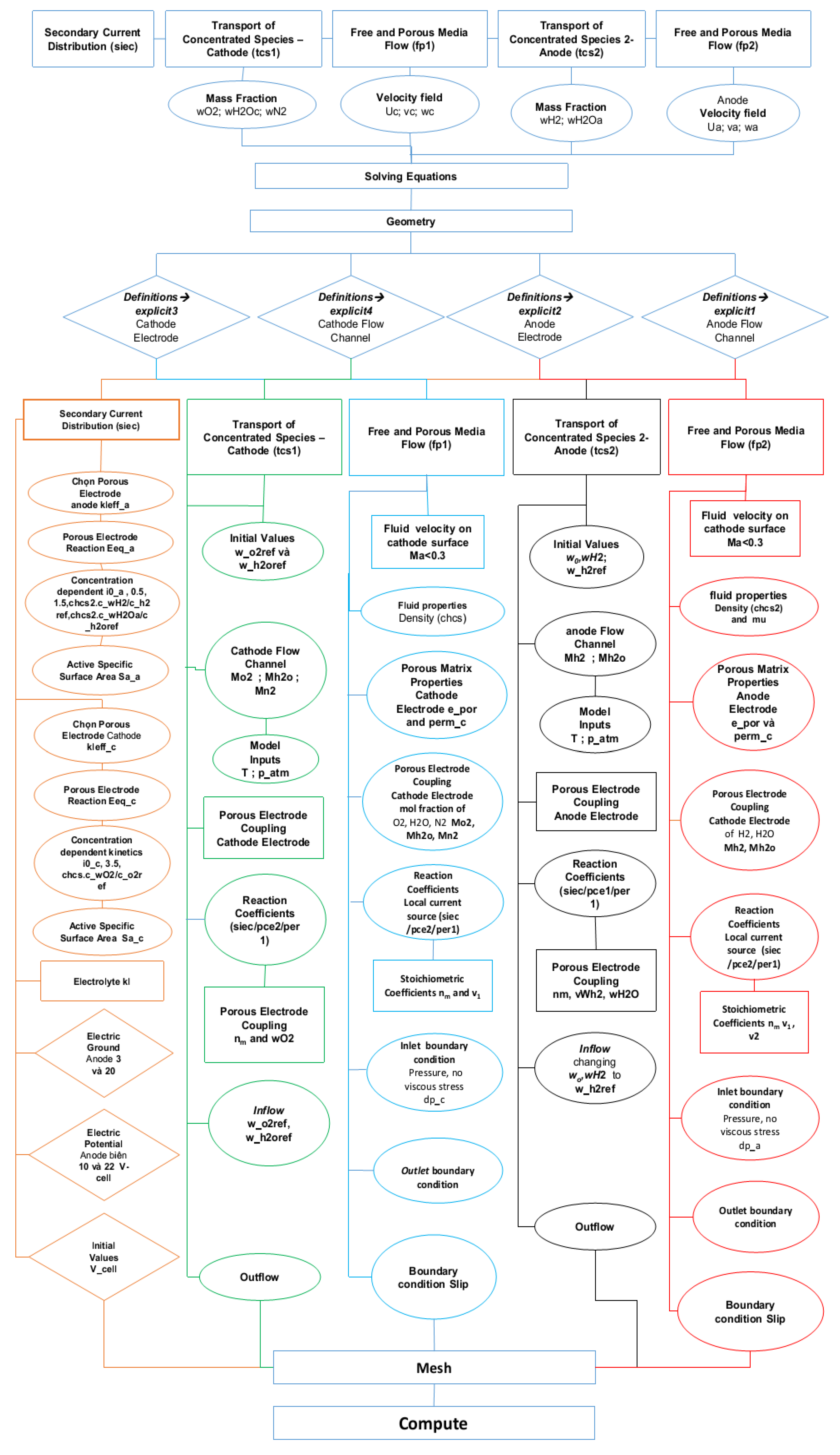
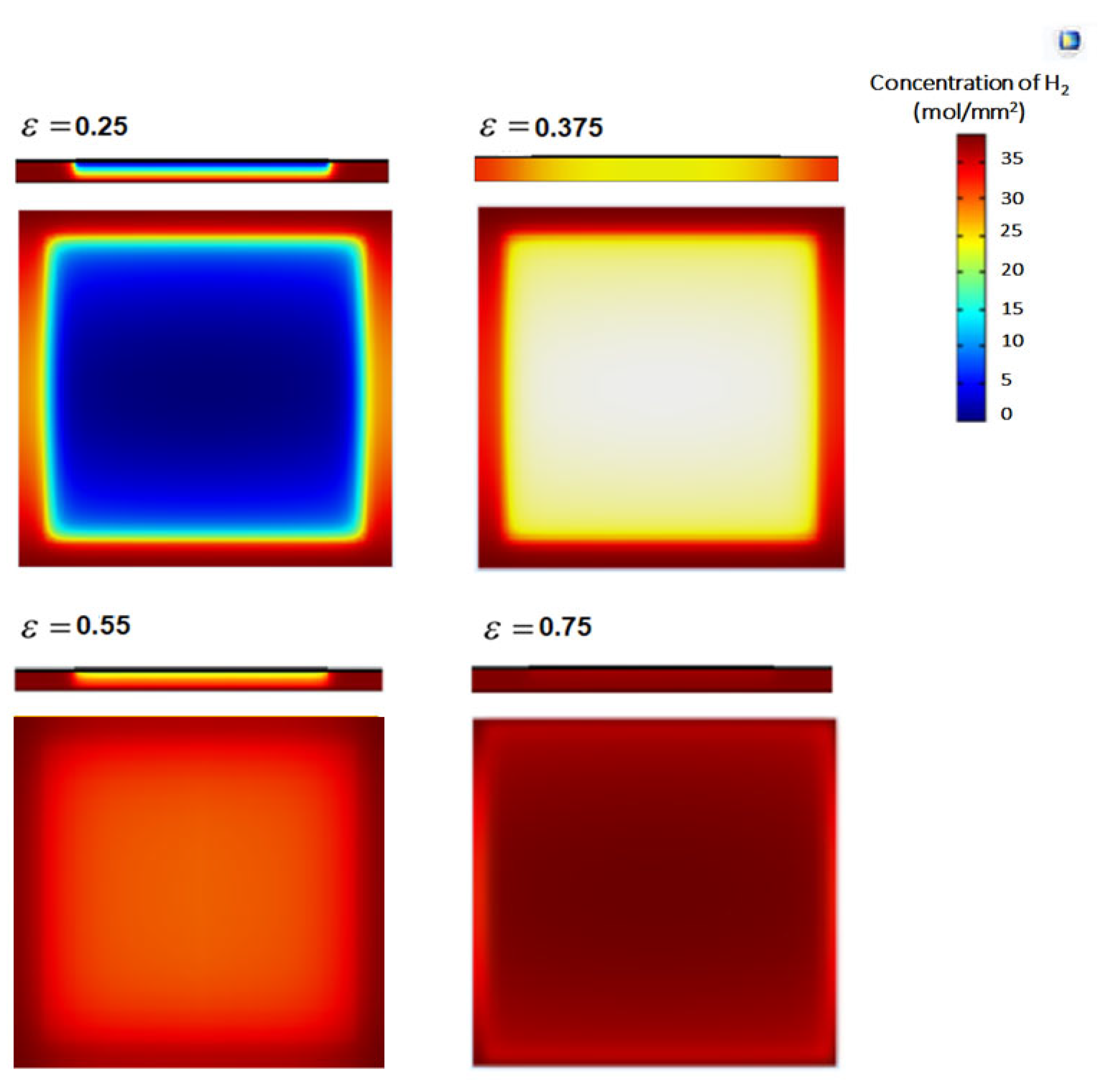
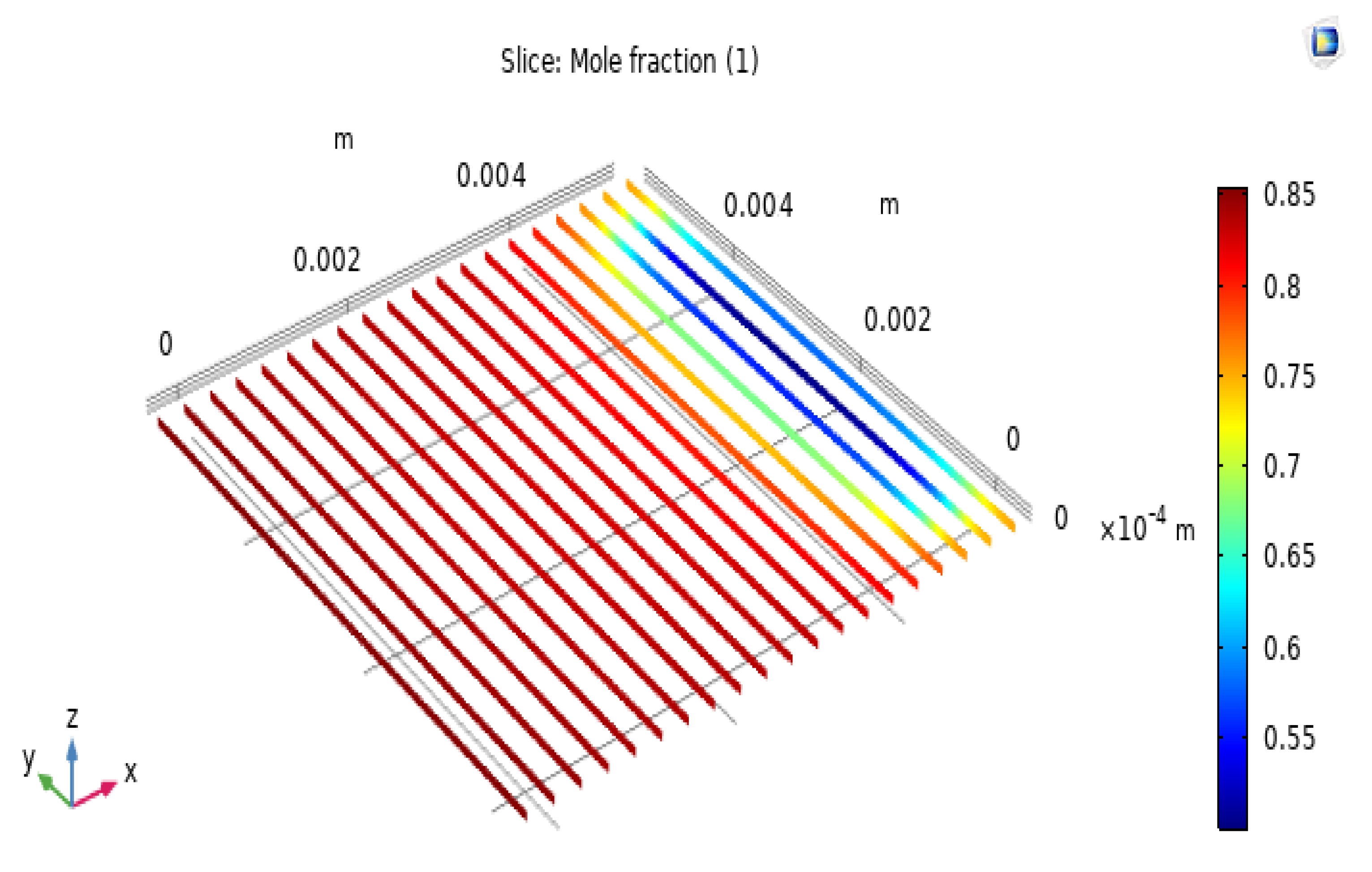
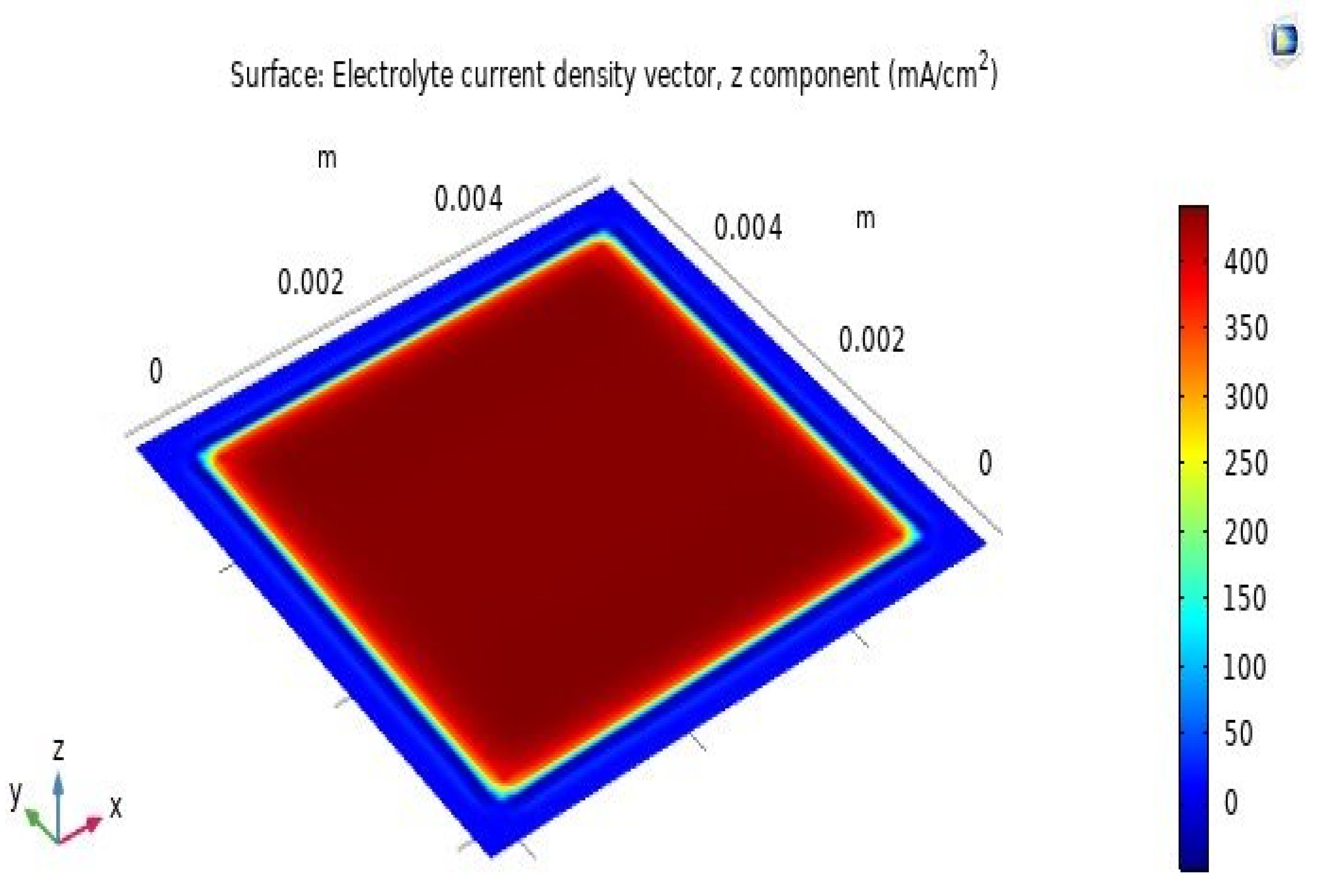

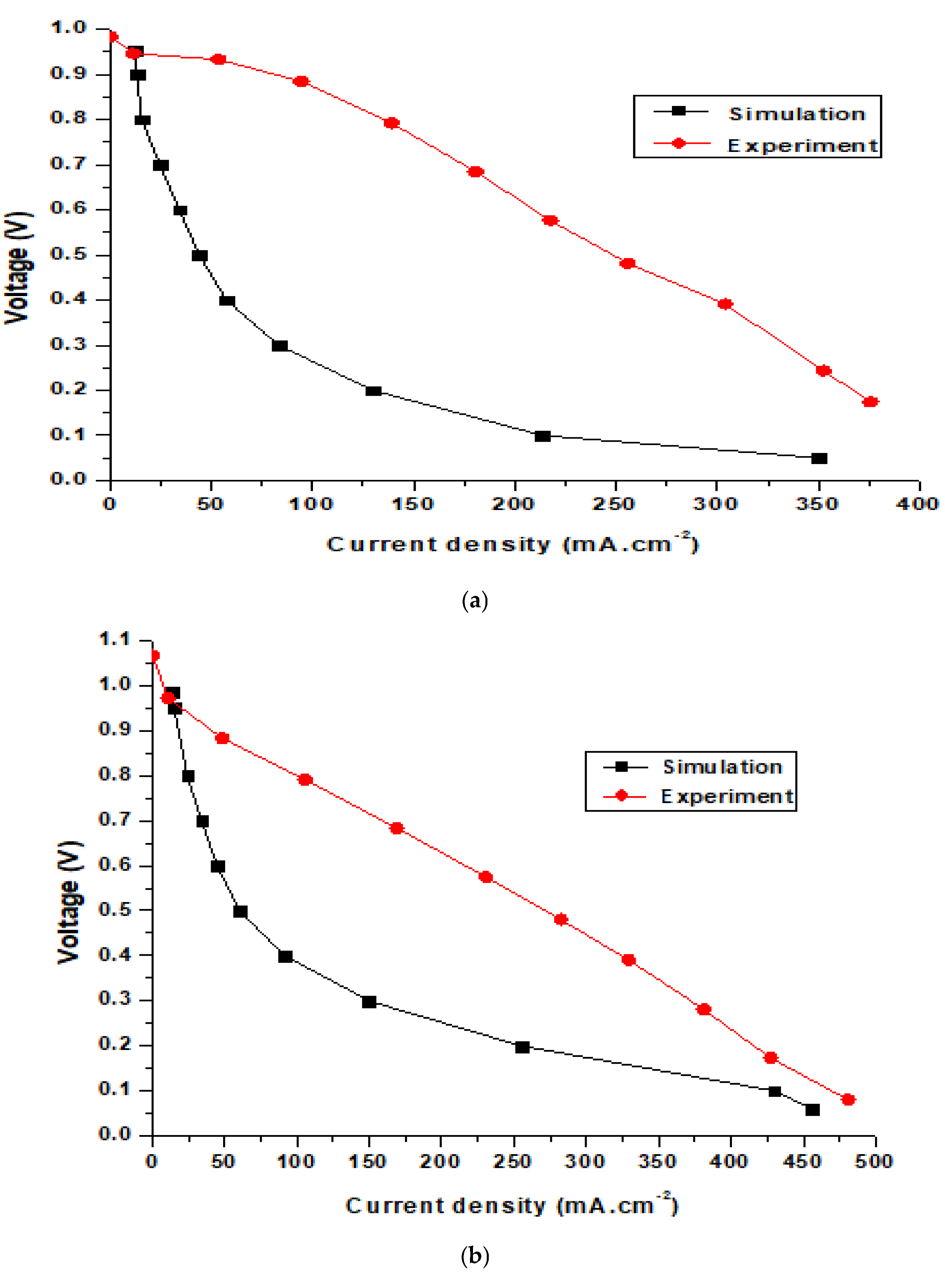
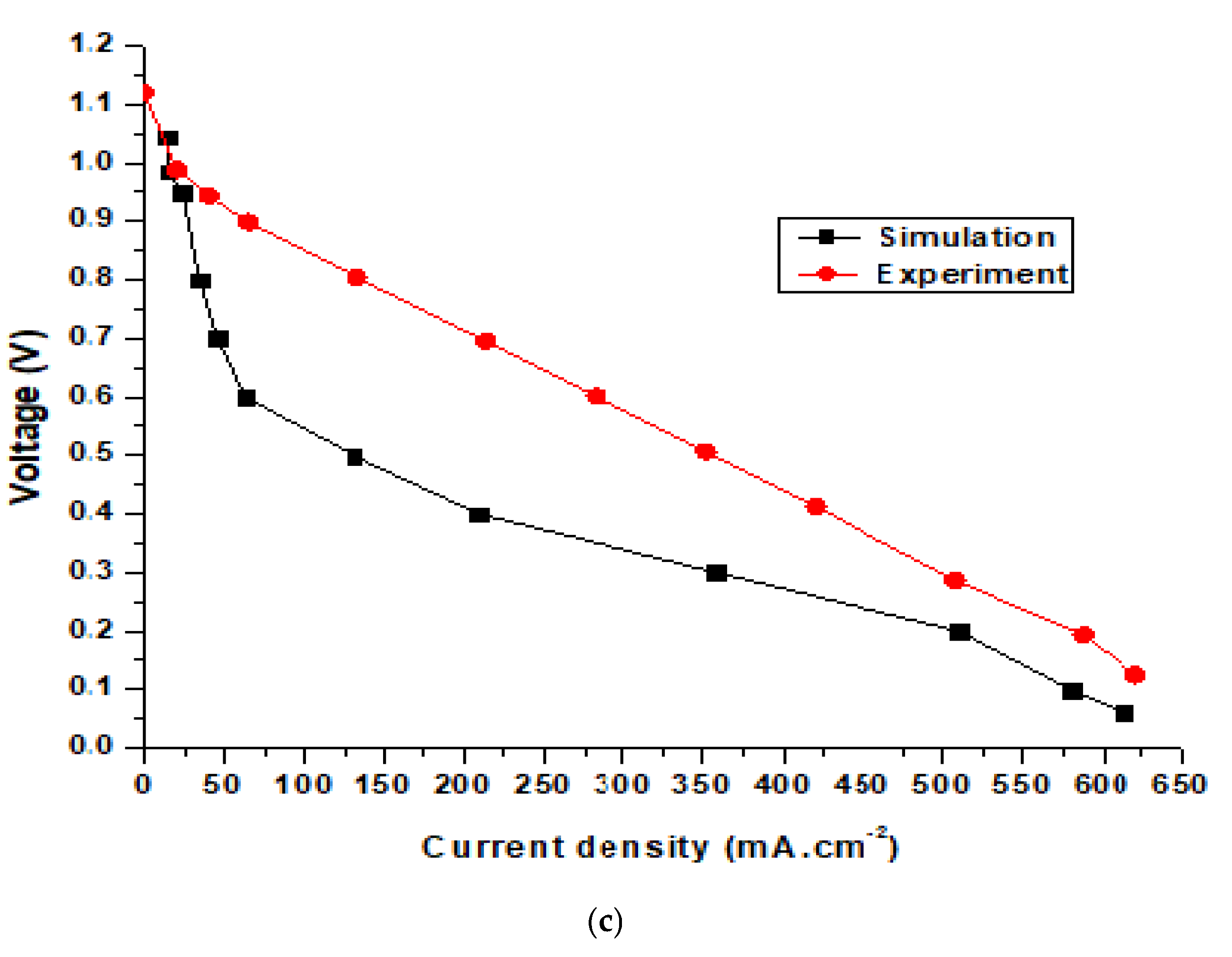
| Components | No. of Layer | Values and Units | Active Area |
|---|---|---|---|
| Thickness of H2 electrode | 3 | 540 μm | 6 cm × 6 cm |
| Thickness of electrolyte | 1 | 18 μm | 6 cm × 6 cm |
| Thickness of O2 electrode | 2 | 20 μm | 5 cm × 5 cm |
| Flow rate of H2 | 200 mL.min−1 | ||
| Flow rate of O2 | 400 mL.min−1 | ||
| Pressure | 1 atm | ||
| Temperature | 650 °C, 700 °C, 750 °C |
Disclaimer/Publisher’s Note: The statements, opinions and data contained in all publications are solely those of the individual author(s) and contributor(s) and not of MDPI and/or the editor(s). MDPI and/or the editor(s) disclaim responsibility for any injury to people or property resulting from any ideas, methods, instructions or products referred to in the content. |
© 2025 by the author. Licensee MDPI, Basel, Switzerland. This article is an open access article distributed under the terms and conditions of the Creative Commons Attribution (CC BY) license (https://creativecommons.org/licenses/by/4.0/).
Share and Cite
Nguyen, X.-V. Three-Dimensional Simulation of the Operating Characteristics of Cell Layers in Solid Oxide Fuel Cells. Appl. Sci. 2025, 15, 4462. https://doi.org/10.3390/app15084462
Nguyen X-V. Three-Dimensional Simulation of the Operating Characteristics of Cell Layers in Solid Oxide Fuel Cells. Applied Sciences. 2025; 15(8):4462. https://doi.org/10.3390/app15084462
Chicago/Turabian StyleNguyen, Xuan-Vien. 2025. "Three-Dimensional Simulation of the Operating Characteristics of Cell Layers in Solid Oxide Fuel Cells" Applied Sciences 15, no. 8: 4462. https://doi.org/10.3390/app15084462
APA StyleNguyen, X.-V. (2025). Three-Dimensional Simulation of the Operating Characteristics of Cell Layers in Solid Oxide Fuel Cells. Applied Sciences, 15(8), 4462. https://doi.org/10.3390/app15084462






